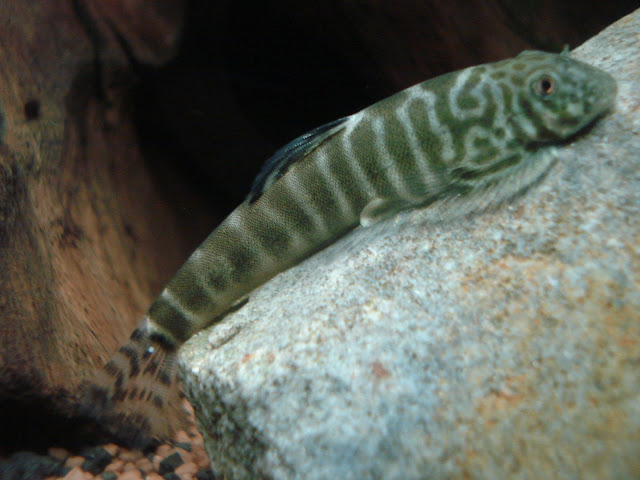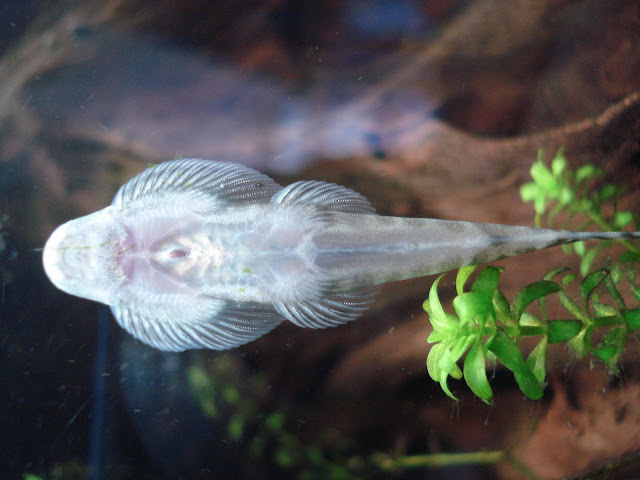Page 1 of 1
Which Hillstream Loach is this?
Posted: Sat Aug 22, 2009 4:28 pm
by Francois van Brederode
I was at a big aquarium store today to get an extra powerhead for my hillies, and to get somevery nice Sewellia when I spotted these hillies swimming in a tank of Pseudogastromyson Cheni.
Because they looked like nothing I had ever seen before I just had to take them with me, you know the feeling

I knew I could give them what they need, because there hillies, right?
But exactly wich species they are is not completly clear to me.
Some pics:



I'm in doubt wether they are:
Neogastromyzon crassiobex
Or
Protomyzon whiteheadi
But what do you think???
Posted: Sat Aug 22, 2009 4:40 pm
by Sawyer
Posted: Sat Aug 22, 2009 5:33 pm
by plaalye
Posted: Sat Aug 22, 2009 6:31 pm
by Jim Powers
I would go along with P fasciatus, too.
Nice find!! They are a great hillstream to keep.
Posted: Sun Aug 23, 2009 2:58 am
by Mad Duff
Going by the squiggle marking behind the head I would say either
P. fasciatus or
Pseudogastromyzon sp that Odyssey has shown photos of, either way a very nice looking fish

Posted: Sun Aug 23, 2009 5:21 am
by Francois van Brederode
@Sawyer, It's definetly not a Pseudo. cheni.
I keep them with P.cheni and they are very different in markings, body shape and fin placement.
The fins do not overlap like most hillies.
@plaalye, Jim & Duff I don't think its P. faciatus either.
It has absolutly no yellow colouring in either fins.
(It may develop the colours when its de-stressed)
Also in faciatus there are spots running over the fins, mine have big blotches.
GAH, I should have taken pictures of the bellie shoudn't I?
I'm still going with:
http://www.loaches.com/species-index/pr ... whiteheadi
Because of the seperate pelvic fins.
Posted: Sun Aug 23, 2009 6:09 am
by odyssey
Hi Francois van Brederode!
Your Pseudogastromyzon sp seems to be the same fish species as a newcomer at me.
http://forums.loaches.com/viewtopic.php?t=18916
There is the discussion about Pseudogastromyzon sp in this past forum in the following links.
Please refer to it if you like.
http://forums.loaches.com/viewtopic.php?t=17369&start=0
http://forums.loaches.com/viewtopic.php ... 9&start=15
Posted: Sun Aug 23, 2009 9:01 am
by Francois van Brederode
They do look a lot like P. fangi, ecept the spots on mine don't travel as far over the body, both specimens I have have the spots confined tot the head only.
They look pretty much exactly like the one fighting your Sewellia
Both in markings an lack of fin colour.
The other pictures all have different markings...
Also, they have settled down now, and still no yellow colour on any fins.
I did find out that they love digging and rooting trough the gravel.

And that they don't shy away attacking a Sewellia twice there size, and winning!

I have a pic of the bellie:

It might be helpful
Posted: Sun Aug 23, 2009 9:54 am
by Jim Powers
It takes time for the fins to turn yellow in my experinence.
Posted: Sun Aug 23, 2009 6:15 pm
by ch.koenig
hi francois
I agree with jim. the
p. fasciatus I showed in onother thred turned after some time into a light brown-rose with yellow dorsal and caudal fins. beautiful fish. but: no blotches but spots
http://forums.loaches.com/viewtopic.php ... astromyzon
yesterday I was asked in a LFS what species a single hilli could be: beautiful yellow fins ... but a faint stripe marking! I consider it as
p. sp "tungpeiensis" like yours. the only specialist on this matter is the chinese ichthyologist Zhou Hang. all "not-chinese" scientists don't know the language and have hardly access to the professionell literature in this language. another problem is the absence of a revision. oficially "tungpeiensis" is not valid, but used by Zhou Hang.
http://forums.loaches.com/viewtopic.php?t=17369&start=0
I would say: two different species. and both hard fighters. if you want permanent action take chenis, myersis, fasciatus or some sp.
cheers charles
Posted: Mon Aug 24, 2009 1:58 am
by Francois van Brederode
Hard fighters they definetly are!
Frantic diggers as well.
I will await the colour to come trough.
I'll be going with P.tungpeiensis for the moment as they have blotches instead of spots.
Now I can put a name on them.
Thanks



